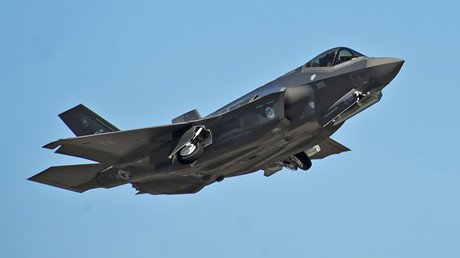Pentagon prepares ‘misleading’ response to Senate’s F-35 concerns – report

The Pentagon has reportedly been preparing a “misleading” response to the Senate’s criticism of delays in the F-35’s progress. An internal memo pointed at “prevarications” regarding the stealth combat aircraft’s development timeframe.
“If not changed, the existing responses would at best be considered misleading and at worst, prevarications,” the Pentagon’s director of operational testing, Michael Gilmore, wrote in a memo obtained by Bloomberg.
READ MORE: Israel orders 17 additional F-35 jets, expects first batch by year's end
The internal document appears to criticize the Pentagon’s draft report, meant to be sent to Senator John McCain (R-Arizona), who questioned Defense Secretary Ash Carter on the progress setbacks facing the Lockheed Martin F-35 Lightning II in early November.
“I am extremely disappointed to learn of yet another delay in the completion of the System Development and Demonstration (SDD) phase of the F-35 Joint Strike Program,” Senate Armed Services Committee Chairman McCain wrote in a November 3 letter. He specifically asked the Defense Department “provide responses” to a total of 10 questions.
However, according to Gilmore’s assessment, some answers the Pentagon drafted “ignore acknowledged facts, are ambiguous and misleading and if signed and sent as-is” could “generate substantial issues with ... Congress.”
Gilmore pointed to three answers, in which the DoD was not quite accurate.
In response to McCain’s question on when the Pentagon could complete the SDD phase of the F-35, the department’s officials wrote that it was due to end in “early 2018.”
Gilmore recommended that the Pentagon “state clearly that development flight testing will not complete – at the earliest” – until mid-2018.
Regarding operational combat testing, the Pentagon reportedly stated that it would start in mid-2018 and be completed a year later. Gilmore labeled the response “false,” because the tests, he said, would begin “no sooner than late 2018, or, more likely, in early 2019 but could be as late as 2020.”
Moreover, Gilmore stressed, live-fire testing of the F-35’s gun system also faces new delays. During November flights, symbols shown on the helmet displays used by pilots to aim air-to-ground attacks were deemed “unusable and unsafe.”
There are also issues with the Navy’s version of the plane, the F-35C, which, Cilmore said, has “inadequate” wing strength and is not capable of carrying a primary weapon, the AIM-9X short-range air-to-air missile, at some altitudes and airspeeds.
The miracle that wasn’t: Navy hammered in Senate over ‘failed’ ship design https://t.co/dmWi5ijMwV
— RT (@RT_com) December 3, 2016
Gilmore’s spokesman, Army Major Roger Cabiness, also told Bloomberg that “this is a serious deficiency that would have restricted” a F-35C flight with the missile.
Cabiness addressed “excessive F-35 vertical oscillations,” or shaking, in catapult launches from aircraft carriers, something that Gilmore has also mentioned. In the words of Cabiness, the Navy considers it a “must-fix deficiency,” but he does not expect that it can be done within the development phase.
The “program waited so long to take action that it is unlikely a solution can be implemented within” the development phase “unless a quick fix is developed soon,” Cabiness wrote.
US Navy’s costliest-ever carrier USS Gerald Ford ‘unlikely to succeed in combat’ – leaked DoD memo https://t.co/ppXwIXcBuC
— RT (@RT_com) July 22, 2016
Rear Admiral Roy Kelley, director of the Navy’s F-35C integration office, has confirmed to Bloomberg that the development phase “has identified a few F-35C specific discrepancies, to include the load limitations for carriage of AIM-9X, as well as the vertical oscillations during catapult launch.”
He assured that a potential fix for the wingtip limitations “has already been implemented with the modification of the outer wing panel on F-35C.”
Gilmore concluded that the Pentagon’s draft response should “be revised to provide clear, accurate and complete answers.”
In November, the F-35 program office asked the Pentagon to provide additional $500 million to finish development on the F-35 Joint Strike Fighter.
Development work on the jet has already eaten up 15 years and over $55 billion, making it America’s costliest weapons program. Originally scheduled to end in 2012, the development phase was extended through 2016 and given another $476 million in funding during a 2010 reorganization.
US dominates global arms sales – study https://t.co/9XC4v2HgYC
— RT (@RT_com) December 6, 2016
Officially, the F-35 has already entered service in the US Marine Corps and the Air Force, with the Navy version expected to follow suit in 2018. In practice, however, the futuristic jet is plagued by more than 1,300 problems catalogued by the Pentagon inspectors, and requires more testing, patching and tweaking before it could actually replace the existing combat aircraft.
READ MORE: US authorizes F-15 fighter jet deal with Qatar, worth over $21bln
On October 14, Gilmore detailed the problems with the jet in his memo, pointing at the main gun’s design deficiencies, too few aircraft available for testing, and over 1,000 “significant” problems with the plane’s sophisticated software. He recommended the program be restructured again and “provided the additional resources it clearly requires to deliver its long-planned and sorely needed” full capability, Bloomberg reported at the time.














